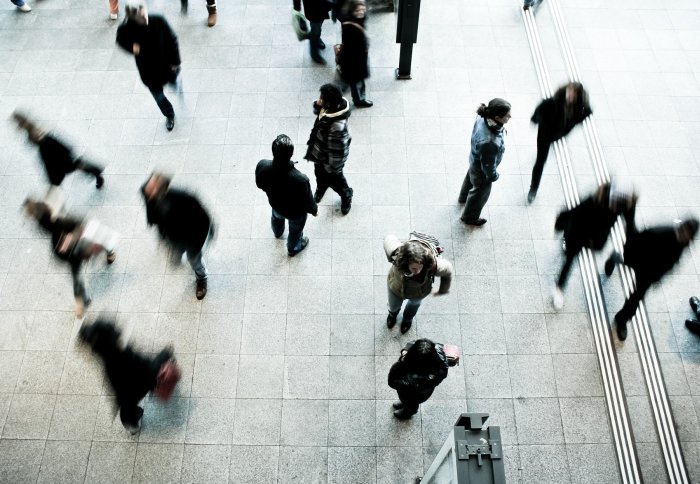

Alastair Shipman is unearthing how people react when confronted by a threat such as a terrorst incident.
If you were confronted by a knife-wielding terrorist, how would you react?
A surprising number of people say they would confront the attacker, but most say they would run (the official advice). In the moment however people probably don’t react as they imagine.
This is according to Alastair Shipman, a PhD student at Imperial College London. Alastair’s research – the first of its kind in the public domain – is shedding important light on how crowds react during terrorist incidents.
The research is being conducted in the Department for Transport Studies and draws upon a range of disciplines, from engineering to human physiology to psychology. It’s not an easy research topic if you’re working publicly however.
“One problem is that there is no publicly available data.” explained Alastair. “The best data sources would be CCTV camera recordings of actual terrorist incidents but these are highly sensitive and so cannot be accessed for public research.”
The lack of public data means that only very limited research on crowd dynamics during terrorist incidents has been conducted to date, and all of it in private.
However, it is increasingly an area of interest for companies working on infrastructure projects.
If they can understand and model how crowds react in these circumstances then they can identify how the built environment might be designed to facilitate the most favourable responses. They can also improve how they provide advice to help people to react in the safest way.
Experimental approach
With no precedent to look at in the literature, and no public data, Alastair has had to design experiments from scratch to capture his own data.
His experiments seek to recreate a hostile atmosphere in a controlled environment.
A group of volunteers are put into a room at set positions, are told that they will be paid to perform a task, but that they’ll only receive the money if they do so to completion.
After a short period an actor enters the room shouting in a hostile manner, and ‘targets’ one of the volunteers by trying to grab them. The volunteers have been told that if they are touched by the actor they will fail their task and not be paid. To be successful they must avoid the actor, and can even leave the room if they wish, via the open door (they are all paid at the end of the experiment regardless).
One would think that the volunteers would simply flee the scene – which is what most people reported they would do in pre-experimental surveys -- but it isn’t as straight forward as that.
“What we’ve seen so far is that there is a huge social effect in individual decision making” said Alastair. “I’ve run experiments where literally nobody moves, and the attacker can leisurely target the volunteers one by one. However, if one person starts moving, then the other participants start moving too. It’s uncertain initially why this happens. It could be that they want to move, but don’t feel confident in doing so, or that they are inspired to do so when they observe another participant moving.”
In a real-life situation, the police say that running is absolutely the best thing to do.
Scaring people
The real challenge with designing these experiments is adding what Alastair calls the “fear factor” so that people react in as realistic a manner as possible.
Alastair hopes that his methods can capture and model this to some degree. He is measuring the levels of cortisol – the stress hormone -- of the participants, alongside other physiological and self-assessed measurements, and also consulting psychologists and behavioural experts to see how his observations match up to their expectations.
“There is a lot of existing research into how pedestrians move through the built environment and how crowds move during controlled fire drills. But both of these lack the ecological validity to properly represent human behaviour. It’s well known that people react quite differently when scared, but even the best software can’t account for this, yet.”
VR studies
One limitation of these studies is the nature of the emergency. Having an actor chase people is relatively straight forward, but testing other types of incident, such as an explosion, is not.
One potential solution is to use virtual reality. However, to date no studies exist to confirm that people react in the same way when in VR. This lack of understanding is what Alastair has addressed.
To do this he replicated his physical experiments, both in terms of the environment and the other participants, but in VR. In the original physical studies there were multiple test subjects which formed the crowd. In the VR studies he had only one test subject at a time, but replicated the others with avatars. Their movements and responses were recorded in the physical world and incorporated into the VR world.
Interestingly, the reactions of the test subjects in VR was true to the real world, including their movement and physiological response (heart rate, sweat response).
This is an important study as it demonstrates that VR studies might be considered reliable, which expands the ability to model and plan for emergencies.
Ongoing work
Alastair is working with both academics and consultancy companies to bring this research to commercial reality. This includes adapting existing software to represent the observed behaviour, as well as continuing this research to cover as many scenarios as possible. The work that has been completed is just the first step on a long road to understanding, and eventually predicting, people’s reactions during terrorist attacks.
Article text (excluding photos or graphics) © Imperial College London.
Photos and graphics subject to third party copyright used with permission or © Imperial College London.
Reporter
Max Swinscow-Hall
Institute for Security Science & Technology



